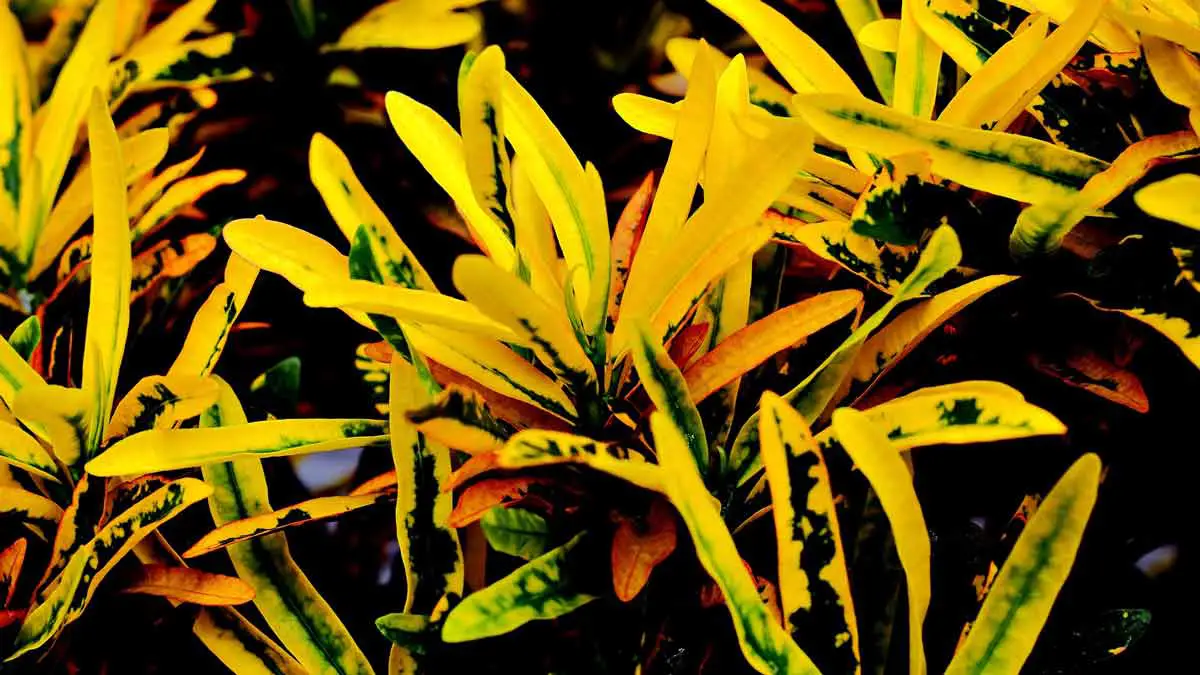If your Croton plant’s leaves are turning black, it may be a sign of over-watering or poor drainage. Ensure the plant is not sitting in standing water and adjust the watering schedule accordingly. If the problem persists, it could indicate a more serious issue with the plant’s health, and it may be dying.
Due to their bold, multi-colored leaves, Croton plants are a stunning addition to any home or garden. They thrive as houseplants and can even survive outdoors if the climate is warm enough.
Unfortunately, black croton leaves are an all-too-common sight for gardeners.
There are a variety of explanations for why this might be happening, but understanding why it’s occurring and how to fix it can help bring the plant back to life.
In this article, we’ll explore 10 common reasons Croton leaves may turn black and how to get your beloved plant looking lush and vibrant again.
Why Are My Croton Leaves Turning Black, and How Can You Fix It?
A number of factors may cause the blackening of croton leaves. The most frequent culprits include:
1. Overwatering
When caring for croton plants, it is important to keep a careful balance between providing enough moisture and overwatering. If too much water is given, the leaves will turn black and eventually fall off.
As native to tropical climates, croton plants prefer consistent moisture and humidity levels to thrive.
Soggy soil can be detrimental to their health, leading to discoloration and wilting of the leaves. Overwatering can also cause root rot which further damages the plant.
How To Tell If You Are Overwatering Your Croton Plant
Watering your Croton plant too much can have severe consequences. One of the most apparent signs of overwatering is that the leaves will start to change color and eventually drop off the plant.
The Croton leaves will become yellow, brown, and then eventually black. Additionally, the plant’s stems may begin to soften and droop while the root system begins to rot.
If you notice any of these signs, you must take action quickly to stop further damage from occurring. Otherwise, your Croton plant may not survive for long.
How To Fix Overwatering
When it comes to caring for a Croton plant, one of the most important things you can do is watch your watering habits.
To avoid overwatering, only give your Croton enough water once a week or when the soil feels completely dry to the touch. It’s also wise to use a pot with drainage holes to ensure that any excess water can escape and not accumulate at the bottom of the pot.
Furthermore, repotting your croton in a well-drained soil mix will help improve drainage and stop overwatering from occurring in the future.
2. Pest Infestation
Pests such as aphids, whiteflies, and mealybugs can wreak havoc on croton plants, leaving their leaves turning black. By feeding on the plant’s sap, these pests can significantly impact your croton’s health.
Not only will your Croton’s leaves start to turn black, but you may also likely experience leaf drop and stunted growth due to the infestation.
To keep your Croton healthy, removing and preventing these pests is important.
How To Tell If Your Croton Plant Has A Pest Infestation
Croton plants may display a few signs of pest infestation, which can be identified with careful observation.
The most common indication is the appearance of black or brown spots on the leaves. These will gradually spread until the entire leaf turns yellow before turning black or brown and dropping off the plant.
As the pests feed and move on the leaves and stems, they leave behind a sticky coating that can further indicate their presence.
In some cases, you may even spot the pests themselves. If any of these signs are observed, it is best to take action quickly to remove the pests from the plant before more damage occurs.
How To Control Pests On Croton Plants
Using your hands is the most effective way to remove pests from croton plants.
The application of neem oil should be used to ensure that pests are removed and discouraged from returning.
Insecticidal soap is also an effective solution, safe for humans and animals while eliminating pests.
When applying any pesticide, following the product label’s directions should be strictly followed to ensure safety and effectiveness.
3. Fungal Disease
Croton plants are particularly susceptible to fungal diseases, which can cause their leaves to turn black.
The two most commonly seen fungal diseases in Croton plants are black spot and anthracnose. These illnesses present themselves as dark brown or black spots that appear on the leaves, leading to leaf drop.
Fungal diseases are more likely to occur under humid conditions and require diligent attention from gardeners to ensure that they do not spread across the plant.
How To Tell If Your Croton Plant Has A Fungal Disease
Croton plants may be affected by fungal diseases, but there are several signs you can look for to tell if your plant is affected.
One of the most common symptoms is black or brown spots appearing on the leaves. The spots will gradually spread until the entire leaf turns yellow, brown, or black and falls off the plant.
You may also notice a powdery substance on the leaves and stems, indicating further infection. This powdery substance is made up of spores from the fungus attacking your plant.
In some cases, you may observe small lesions forming on the stems and buds and circular patches occurring directly on the leaves.
How To Control Fungal Diseases On Croton Plants
Watering your Croton plant at the base is a great way to help mitigate fungal diseases and help stop it from spreading.
Wherever possible, carefully remove any leaves that have become affected and dispose of them properly.
Applying a fungicide to the plant is also important in controlling fungal diseases on croton plants; always ensure you read the instructions on the product label carefully and follow them accordingly.
In addition to using a chemical fungicide, natural alternatives can be applied, such as cinnamon or baking soda, which may prove just as effective in warding off fungi.
4. Bacterial Disease
Croton plants can be susceptible to bacterial diseases, which can cause their leaves to darken and drop.
One of the most common bacterial illnesses affecting crotons is bacterial leaf spot. This disease presents itself through black or brown spots on the leaves and can spread quickly under humid conditions.
How To Tell If Your Croton Plant Has A Bacterial Disease
The signs of a bacterial disease in a Croton plant can be easily identified.
You may notice black or brown spots on the leaves, which will eventually turn yellow and brown or black before the plant is dropped.
Additionally, you may observe a slimy and wet substance on the leaves or stems near the affected area. This sliminess is an indication that bacteria have caused the infection.
If left untreated, the bacterial disease could spread further throughout the plant and cause more significant damage.
How To Control Bacterial Diseases On Croton Plants
Watering your Croton plants at the base is the best way to prevent bacterial diseases from spreading. This will help keep the disease contained within infected leaves and stop it from further damaging other parts of the plant.
To ensure maximum efficacy, it’s important to remove any affected leaves immediately and dispose of them properly, as leaving them in contact with healthy foliage could encourage the further spread of the disease.
Applying a bactericide is also an effective way to control bacterial diseases in Croton plants.
Chemical-based treatments are available; however, you can use household items such as vinegar or hydrogen peroxide for a more natural approach.
Always follow the directions on the product label for accurate application and safe handling procedures.
5. Fertilizer Burn
Fertilizer burn is a frequent issue that can cause croton leaves to darken in color. This phenomenon occurs when the plant is subjected to excessive fertilizer.
The result is that the fertilizers act as a caustic agent, burning the plant’s roots and consequently damaging the leaves, thus leading them to take on a black hue.
How To Tell If Your Croton Plant Has Fertilizer Burn
The telltale signs of fertilizer burn in a Croton plant are unmistakable.
Wilted and yellowing leaves will start to curl and drop off the plant, appearing to be scorched by fire.
Even more noticeably, the leaves will show black or brown spots from their tips all the way to their bases, with a dry and parched texture that is often accompanied by an unpleasant smell.
In addition to these physical symptoms, you might also notice that older growth won’t look as vibrant as it normally does, tending instead to have a faded appearance.
Ultimately, if your croton’s leaves become brittle and fall off even after adequate hydration and environment control, it’s likely due to fertilizer burn.
How To Control Fertilizer Burn On Croton Plants
It is important to take the necessary steps to avoid fertilizer burn on Croton plants.
Firstly, it is essential to flush the soil with water to wash away any excess fertilizer that has been applied. This helps to prevent the build up of too much fertilizer in one area.
Secondly, it would be advisable to abstain from fertilizing the plant for a few weeks to give it time to recover and lessen the effects of the fertilizer burn.
Lastly, pruning off any affected leaves can help improve the overall appearance of your Croton plant and help it get back on track toward healthier growth.
6. Sunburn
Croton plants require bright, indirect light to thrive, but too much direct sunlight can cause sunburn and result in the leaves turning black. This adverse reaction is caused by UV radiation from the sun damaging the cells of the leaves, resulting in the discoloration of their surfaces.
Sunburn can also weaken a plant’s photosynthesis process, causing it to produce less chlorophyll and grow more slowly than usual.
Specifically, when exposed to too much direct sun for extended periods at a time, croton leaves may become dry and brittle before gradually turning black.
This damage can also be compounded if other environmental factors, such as high temperatures or inadequate watering, are present.
Therefore, it is important to monitor how much direct sunlight your croton plant is receiving to avoid sunburn and resultant leaf discoloration.
How To Tell If Your Croton Plant Has Sunburn
Croton plants can succumb to sunburn if they are exposed to too much sunlight.
You can easily identify if your croton is suffering from sunburn by looking out for its leaves, which will start to yellow before turning black or brown and begin to drop off the plant.
In addition, the leaves may have a scorched appearance and may display dark spots or patches.
When a Croton plant is exposed to excessive sunlight, the UV rays can damage its delicate foliage and cause it to become stressed and weakened.
This damage often results in discoloration of the foliage and wilting of the leaves due to dehydration.
As time passes, the leaves may start curling up and turning brown, while some might even dry up completely before falling off the plant. Direct exposure to strong sunlight also causes green areas on the leaf edges to become burnt.
How To Fix Sunburn On Croton Plants
The Croton plant can be relieved of sunburn through several active steps.
Firstly, moving the affected plant to a shadier area, where it will be exposed to less direct sunlight is advised.
Pruning back any of its leaves showing signs of damage or discoloration can help minimize further damage from sunburn.
Additionally, providing extra water for the roots can help nourish and rejuvenate the plant, but care should be taken not to water the leaves directly, as this could lead to more burn damage.
7. Heat Stress
Croton plants can suffer from heat stress when subjected to excessively high temperatures, devastatingly impacting the leaves.
When exposed to these extreme conditions, the leaves become damaged and can quickly turn black in color.
Heat stress is a concern for Croton plants and all species of plants. It inhibits photosynthesis and disrupts other metabolic processes necessary for healthy growth.
In addition, too much heat can cause the plant to become dehydrated and wilt due to a lack of water.
How To Tell If Your Croton Plant Is Heat Stressed
The signs of heat stress in Croton plants are clear and unmistakable. Examining its leaves allows you to tell if your Croton is struggling with the heat.
The foliage may start to yellow, then turn brown or black and begin to drop off the plant.
Wilting or drooping leaves are also an indication that the plant isn’t getting enough moisture or ventilation to cool itself down.
Other symptoms of heat stress include discolored spots on the leaves, smaller growth than normal, and pale or muted colors compared to a healthy plant.
How To Fix Heat Stress In Croton Plants
Moving your Croton plant to a cooler location is a great way to help alleviate any heat stress that it may be experiencing.
Ensure that the new location gets enough sunlight for the plant but not too much. Make sure to give the plant enough water – check the soil regularly and water when it is dry.
Remove any dead or dying leaves from the plant, as they can take away energy from other parts of the plant and potentially cause further damage.
Adding some mulch around the plant, such as peat moss or bark chips, can help keep moisture in and cool roots down, reducing heat stress on the plant.
If you have placed your croton in a spot that receives direct sunlight all day, consider giving it shade by placing an umbrella or planting taller plants nearby.
These steps should help reduce heat stress and promote healthier growth in your Croton plant.
8. Root Rot
Root rot is a common issue that may lead to the discoloration of croton leaves to black. This happens when the plant’s roots become compromised due to excessive water, inadequate drainage, or other conditions.
Such damage to the root system can be seen in the change of color in its leaves, which turn from green to a deep black.
The consequences of root rot can be severe if not addressed quickly.
As roots are deprived of moisture and nutrients, they start decaying, making it difficult for the plant to uptake water and nutrients necessary for survival. If left unaddressed, this could eventually lead to the death of the entire plant.
How To Tell If Your Croton Plant Has Root Rot
The black or brown spots on the leaves are one of the clearest indications that your Croton plant is suffering from root rot.
You may also notice yellowing, subsequent browning or blackening of the leaves, and wilting and drooping. The roots will usually appear mushy or blackened in this scenario.
Beyond these signs, your croton may show other signs of distress, like dropping leaves, brown patches on stems, stunted growth, and a lack of new leaf growth.
In extreme cases, the root rot can spread to the stem and cause it to weaken and break off at its base. It is important to act quickly if you suspect that your croton has root rot so that you can take steps to save your beloved plant.
How To Fix Root Rot In Croton Plants
Carefully inspect your Croton plant to determine if root rot is present. If so, you should take the necessary steps to treat it promptly and effectively.
Begin by removing the plant from its pot and examining its roots. Cut away any that are blackened or damaged in any way, as these parts of the root system has already been compromised and cannot be saved.
Once all unhealthy roots have been removed, you will need to replant your croton in a new container with a fresh, sterile potting mix.
Pay close attention when watering your plant, as overwatering can worsen root rot and may even kill the entire plant. It’s best to let the soil dry out between waterings, ensuring that it never gets completely saturated or remains excessively dry.
To gauge when it’s time to water again, insert your finger into the soil about an inch deep – if it feels dry, it’s safe to add some water; if still wet, wait for a few days before checking again.
9. Frost Damage
Croton plants can suffer extensive damage when exposed to cold temperatures, resulting in the leaves becoming blackened. This phenomenon is known as frost damage and occurs when temperatures dip below freezing.
The low temperatures cause the cell walls of the Croton leaves to become brittle and dry out, leading to a collapse of their structure and causing them to turn black.
Wind chill and rapid temperature fluctuations can also exacerbate Frost damage, which further damage the plant’s leaves.
It is important for gardeners and homeowners to take precautions against frost damage when growing crotons outdoors by protecting them from cold air or relocating them indoors during the colder months.
How To Tell If Your Croton Plant Has Frost Damage
Croton plants can easily suffer frost damage; there are a few telltale signs to watch out for.
For example, the leaves of affected plants will appear black or brown and wilted, feeling papery and dry to the touch.
Additionally, the stems of these plants become brittle. The leaves will sometimes begin to yellow or redden before turning black due to frost damage.
How To Fix Frost Damage
If you believe your Croton plant has been affected by frost, there are a few measures you can take to get it back on its feet.
To begin with, relocating the plant to a warmer area of the house can help protect against further damage.
Furthermore, to ensure additional protection, it is recommended to cover your plant with a blanket or light fabric. This will provide insulation and keep the temperature constant.
Additionally, giving your Croton extra humidity can help restore it back to health. You can mist your plants regularly or place them on a pebble tray.
Finally, providing extra water will also improve the recovery process, replacing any moisture lost due to frost damage.
As plants do not require large amounts of water all at once, make sure to give your Croton moderate amounts at regular intervals for optimal results.
10. Physical Damage
Physical damage can cause croton leaves to turn black, which occurs when the plant is subjected to physical trauma. This could be due to impacts such as being struck by a rock or gnawed by animals.
The damaged areas may become discolored with a black hue, which can spread across the entire leaf if left unrepaired.
In addition, buds and small branches may suffer fatal blows that need to be pruned away immediately to prevent further issues.
How To Tell If Your Croton Plant Has Physical Damage
Several signs can identify the physical damage to your Croton plant.
You may notice black or brown spots on the leaves and rips or tears in them. Additionally, you could observe that the stems are broken.
When it comes to severe physical damage, there could be discolorations of the leaves, which would appear yellowish and wilt; the leaves may even become floppy and fall off from the stem.
Other possible signs include distorted growth of new leaves, leaf spotting or melting, and stunted growth.
How To Fix Physical Damage In Croton Plants
If your Croton plant is exhibiting signs of physical damage, several measures can be taken to fix the problem and restore its health.
Begin by removing any dead or wilting leaves that may be present and trimming away any stems that have sustained damage.
It’s also important to repot the plant in fresh soil and provide it with extra care and attention – make sure to give it adequate amounts of water and light on a regular basis.
Final Thoughts
Croton plants can suffer from blackening leaves, which is an indicative sign of stress or disease.
It is important to be vigilant in monitoring your Croton’s health and take action immediately when you notice any suspicious discoloration.
By providing a suitable environment and the necessary care, this issue can be remedied, and your Croton will be healthy and vibrant again.







